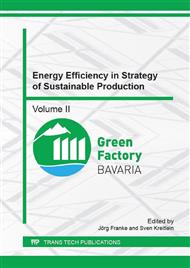p.49
p.57
p.64
p.73
p.82
p.91
p.99
p.109
p.117
Potentials for Energy Saving and Quality Improvement of Assembly Presses Using Data Mining
Abstract:
Modern assembly lines are usually optimized towards output and tact time as well as process capability and quality. Yet, approaches for energy saving are hardly used in assembly presses. Therefore, assembly lines are using more electric power and compressed air than necessary. Especially at high load, during handling phases and in different idle modes there is a huge potential for energy savings. Current research is focusing on high-power consuming turning and milling machines as well as laser welding. Energy saving projects usually focus on whole factory halls instead of manufacturing lines and single assembly machines. Therefore, this paper presents a new methodology using a top-down-approach and data mining analysis regarding a conventional assembly press as well as a whole assembly line. Here, relevant information types like process data, quality factors, expenditure of energy per produced part and power consumption are used to generate more insight into chained assembly processes. Various tools like energy analysis, process flow and correlation analysis are used to identify focus stations of a whole assembly line for energy saving projects and quality improvements. This novel holistic approach regards the electrical power and compressed air consumption of each relevant station and its machine components during different operating states as well as its correlations between process data, quality factors and energy consumption. Besides tact-time-analysis of the process, the scheduled and unplanned downtimes of the machine are also regarded. Furthermore, it enables predictions of tool wear and breakdown, quality impacts of supplied parts, as well as energy savings on process and machine level. Due to an increased quality, the material efficiency may rise as well.
Info:
Periodical:
Pages:
82-90
Citation:
Online since:
November 2016
Price:
Сopyright:
© 2017 Trans Tech Publications Ltd. All Rights Reserved
Share:
Citation:


